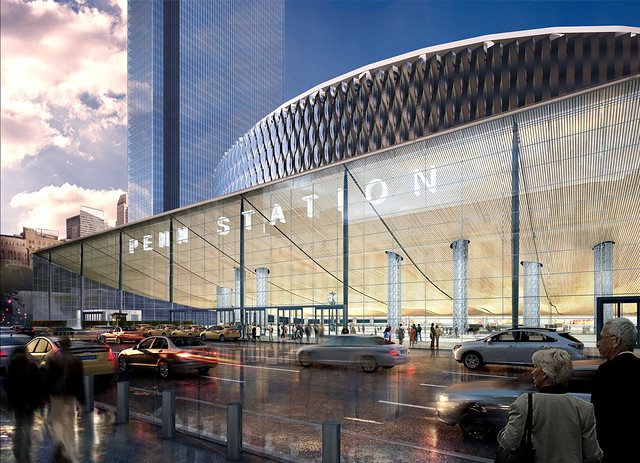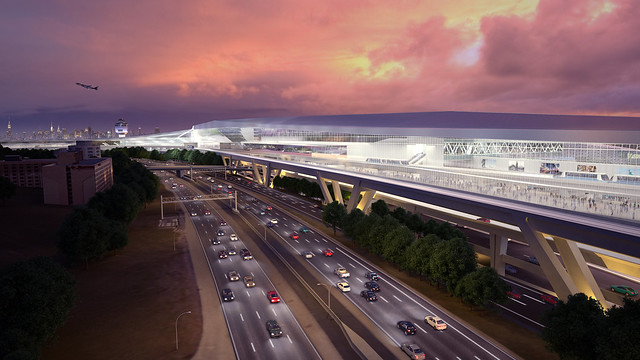
A mixed-traffic streetcar isn’t the way to go, but initial word from the Friends of the Brooklyn Queens Connector is promising.
For a few hours, at least, Gov. Andrew Cuomo’s infrastructure improvement tour is on hold. Thursday’s announcement concerned the Javits Center, and I’ve learned that he’s going to announce a series of technology-related upgrades, including B Division countdown clocks, for the subways on Friday morning live from the Transit Museum. I don’t know if this announcement is in addition to ongoing MTA efforts to bring this technology to fruition or if the timeline for even a Cuomo project will still be 3-5 years as it’s been for the past five years. We’ll find out soon enough.
Meanwhile, the pause in this tour allows us a chance to examine another story regarding New York City transportation that nearly sneaked in under the radar this week. A few months after hearing about what one person called a “cool idea” to initiate a waterfront streetcar that would connect Brooklyn and Queens, word of the behind-the-scenes consultant work leaked to the Daily News, and we now have an understanding of what one routing for a $1.7 billion streetcar may be. I’ve learned that this is one proposal being examined, and it’s not yet finalized or even exclusive. It can still be revised and amended, and the final suggestion may look different. But here goes.
As Dan Rivoli reported earlier this week, consultants hired by the Friends of the Brooklyn Queens Connector have identified a 17-mile corridor that could support a light rail line running. The group believes it would connect growing job centers such as Industry City and Dumbo with residential areas such as Red Hook that do not currently enjoy particularly efficient or robust transit options. The route would start near the Brooklyn Army Terminal, pass by Industry City, journey to DUMBO via Red Hook, swing past the Navy Yards and waterfront development in Williamsburg before crossing into Long Island City and terminating in Astoria Cove.

Connecting Sunset Park with DUMBO, Long Island City and Astoria could bridge a current transit gap.
Here’s Rivoli’s report with comments from some who have been involved or watching the project:
A study commissioned for a nonprofit called the Friends of the Brooklyn Queens Connector — whose members include transit experts, community leaders and business giants like Doug Steiner of Steiner Studios, investor Fred Wilson of Union Square Ventures and Helena Durst of the Durst Organization real estate firm — envisions sleek streetcars zipping through 10 neighborhoods along the 17-mile stretch of waterfront land between Sunset Park and Astoria.
The Brooklyn Queens Connector is aimed at linking neighborhoods to new job hubs outside of the Manhattan-centric subway system as the waterfront adds new residential buildings and office space. The study estimates 15.8 million passengers a year in 2035. “Too much of the city is underserved by our transit system, and we need to be looking at ideas like this to create a 21st century network,” said Jill Eisenhard, director of the Red Hook Initiative community group and a member of the nonprofit supporting a tram.
Mitchell Moss, director of NYU’s Rudin Center for Transportation Policy and Management, said the Brooklyn waterfront is going through a “renaissance” but needs better transit options to spread the benefits. “This is a brilliant way to tie together several different areas, which offer jobs, which offer housing, which offer recreation,” said Moss, who is unaffiliated with the group.
The immediate issues I see with this proposal include the approach to service and funding. First, despite the renderings, anything we consider for the waterfront should not be a mixed-traffic streetcar. If the city, or private interests, plans to invest in light rail, it should be a light rail system with a fully dedicated right of way. It should also integrate with the MTA’s fare payment system so the city isn’t instituting a two-fare system as they’ve done with their ferry network.
Costs too are an issue. The reported initial price tag pegs this project at $1.7 billion, including build-out of infrastructure to support new rolling stock, and a $26 million a year operating budget with 16 million riders per year by 2035. The capital costs are necessarily high due to the need to build new shops and purchase rolling stock, but the operating costs aren’t outrageous. The consultants also maintain that light rail would generate “$3.7 billion of new tax revenue, ‘generating more than enough value to pay for its own construction,’ according to the study.”
Already, I’ve seen some backlash to this project. Some have argued that transit development through Sunset Park and Red Hook will increase property value and lead to gentrification which pushes out current residents. This is a slippery slope of an argument that maintains areas attract poorer residents because transit options are lacking but that we cannot invest in transit because transit will lead to value growth that pushes out these poorer residents. I don’t like this argument and believe it plays into my stance that affordable housing has to include transit development. In other words, it’s up to the city to improve transit and maintain affordable housing so people can continue to live where they live but still get around the city.
The second issue is one of need. When this project first bubbled up, I was skeptical. It seemed duplicative of the G train and targeted to wealth New Yorkers who could afford to buy up waterfront property. With an extension to Sunset Park and a routing closer to subsidized housing in Red Hook, the current proposal begins to address some of the issues I had with this plan when it was, as one proponent noted, just a “cool idea.” It connects growing job centers with residential areas in ways the current system doesn’t. Whether it’s a good use of $1.7 billion — or whether it should even cost $1.7 billion — is an open question.
So what we have here then is the start of a potentially good idea. The consultant report won’t be released publicly yet in full, and it’s not clear what the Friends of the Brooklyn Queens Connector will do yet. Someone will have to identify a proper plan and fight for it, and that’s a tall order a time when our governor is running around announcing pet projects and the mayor can’t be bothered with the details of a much-needed transit expansion.







